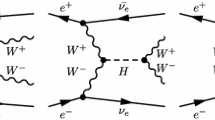Abstract.
The processes of production and subsequent decay of W- and Z-bosons in \(e^+ e^-\) collisions are considered in a recently proposed modified perturbation theory (PT), based on a direct expansion of probabilities instead of amplitudes. In such an approach the non-integrable singularities in the phase space, which are intrinsic in the conventional PT, appear as singularities in the coupling constant (with subsequent compensation by the decay factors of unstable particles). In the present paper the systematic investigation of the modified PT is carried out. The results are compared with the results of the conventional approach, based on the calculation of the amplitude with Dyson resummation. A solution to the problem of the loss of one-loop PT order in the resonance region is found. On the basis of this solution the proof of gauge cancellations in any order of the modified PT is given. A simple generalization of the fermion-loop scheme is proposed which provides a complete description of W-pair production in a next-to-leading order approximation.
Similar content being viewed by others
Author information
Authors and Affiliations
Additional information
Received: 21 February 2000 / Revised version: 18 October 2000 / Published online: 23 March 2001
Rights and permissions
About this article
Cite this article
Nekrasov, M. Finite width effects and gauge cancellations in W- and Z-boson production in the framework of modified perturbation theory. Eur. Phys. J. C 19, 441–454 (2001). https://doi.org/10.1007/s100520100610
Issue Date:
DOI: https://doi.org/10.1007/s100520100610



